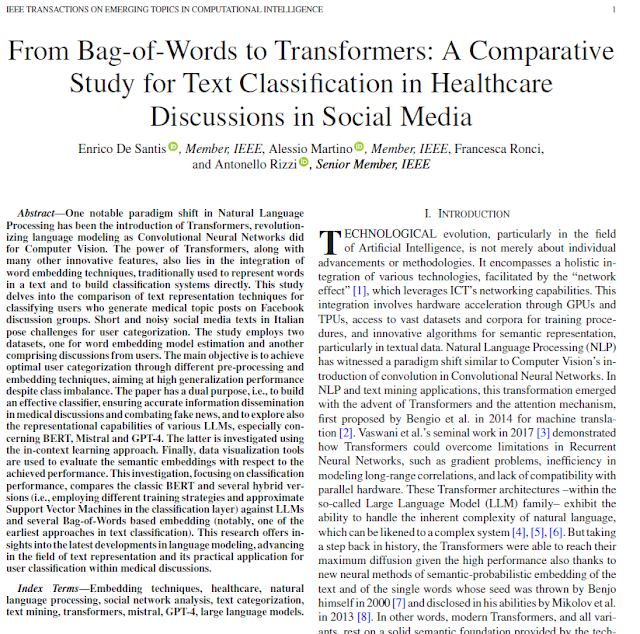Source paper: https://ieeexplore.ieee.org/xpl/RecentIssue.jsp?punumber=7433297
In the ever-evolving landscape of Natural Language Processing (NLP), one
of the most exciting developments has been the rise of Transformer
models. These models have revolutionized the field much like
Convolutional Neural Networks did for computer vision. Our recent study,
"From Bag-of-Words to Transformers: A Comparative Study for Text Classification in Healthcare Discussions in Social Media",
delves into this paradigm shift, focusing on how different text
representation techniques can classify healthcare-related social media
posts.
The crux of our research lies in comparing traditional
methods like Bag-of-Words (BoW) with state-of-the-art models such as
BERT, Mistral, and GPT-4. We aimed to tackle the inherent challenges
posed by short, noisy texts in Italian, a language often
underrepresented in NLP research.
We employed two primary
datasets: leaflets of medical products to train word embedding models
and Facebook posts from groups discussing various medical topics. This
dual-dataset approach allowed us to test the effectiveness of different
text representation techniques thoroughly.
Our findings revealed a
clear winner in the form of the Mistral embedding model, which achieved
a staggering balanced accuracy of 99.4%. This model's superior
performance underscores its powerful semantic capabilities, even in a
niche application involving the Italian language. Another standout
performer was BERT, particularly when fine-tuned, reaching a balanced
accuracy of 92%. These results highlight the significant leap in
performance that modern Transformer models offer over traditional
methods.
Interestingly, while the classic BERT architecture
proved highly effective, our exploration of hybrid models combining BERT
with Support Vector Machines (SVM) yielded mixed results. This
indicates that while BERT’s contextual embeddings are robust,
integrating them with other classifiers requires careful parameter
optimization to unlock their full potential.
In contrast,
traditional methods like BoW and TF-IDF struggled with the
classification task, reaffirming the need for more sophisticated models
in handling complex language data. However, word embedding techniques,
particularly when paired with rigorous pre-processing, still present a
viable alternative, especially in computationally constrained
environments.
A particularly exciting aspect of our study was
examining GPT-4's in-context learning capabilities. GPT-4 demonstrated
impressive adaptability, providing not only high classification accuracy
but also nuanced understanding and semantic explanations for its
decisions. This ability to perform in-context learning opens new avenues
for developing more intuitive and explainable AI systems.
Our
research has significant implications for healthcare professionals and
researchers. By leveraging advanced NLP models, we can gain deeper
insights into patient experiences and public health trends, potentially
transforming how we monitor and combat misinformation in medical
discussions online.
In conclusion, our study reaffirms the
transformative power of modern LLMs in text classification tasks,
particularly in challenging contexts like healthcare-related social
media posts. As we continue to explore and refine these models, we move
closer to harnessing their full potential in real-world applications,
ultimately enhancing our ability to process and understand the vast
amounts of textual data generated every day.



No comments:
Post a Comment